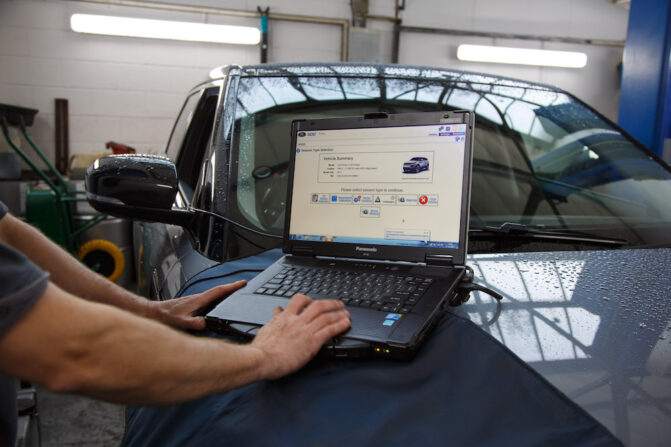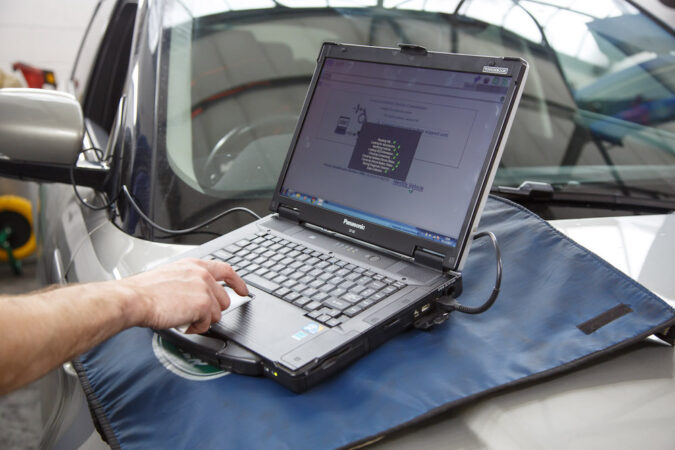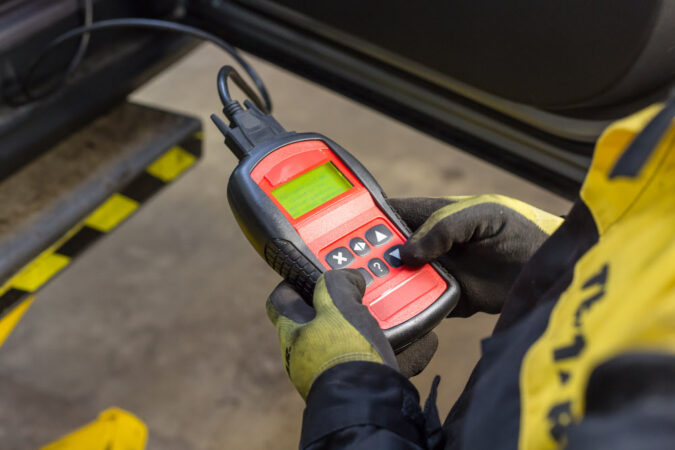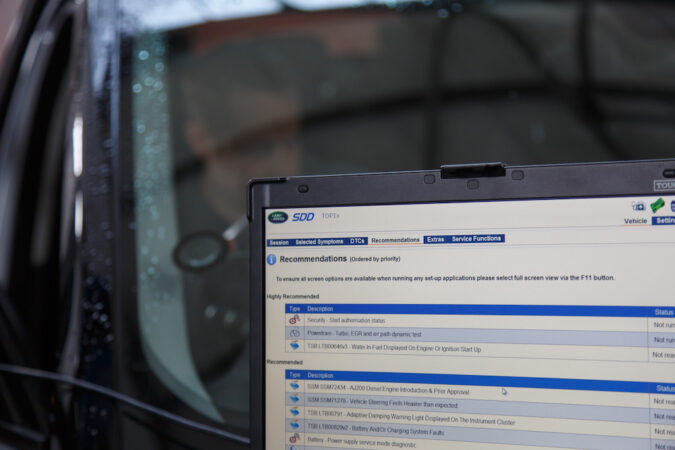If your car is experiencing performance issues, shifting problems, or triggering the check engine light, a faulty PCM could be the culprit. Thankfully, you won’t have to replace the entire PCM to fix this! Reprogramming the PCM – aka reflashing the PCM, car computer software update, or powertrain control module reset – would cost you between $80 to $150.
Doing a PCM (powertrain control module) reflash could resolve your problems without expensive replacements, and best of all, it’s a relatively quick process that involves updating your car’s PCM to restore proper functionality. In stark contrast, replacing the PCM outright is way more expensive, somewhere between $500 to $1,200 for most car models.
So, when exactly should you consider PCM reprogramming, and what if it’s not enough to fix whatever issues you’re having? Further below, we’ll break down everything you need to know, such as how the Powertrain Control Module in your car works, and how it would actually cost you for a PCM reprogramming.
Cost Of PCM Reprogramming At A Dealership
Thankfully, though, the PCM reprogramming cost is relatively cheap. On average, you’ll have to pay around $80 to $150 to reprogram your car’s powertrain control module. The process entails connecting your car’s PCM to a computer with the car manufacturer’s diagnostics and testing software. And then, updating the PCM with the latest software.
For added context, we’ve asked around and found some quotes for average PCM reprogramming costs for some of the most popular automakers here in the US:
| Automaker | Approximate Reprogramming Cost |
|---|---|
| Ford | $80 – $150 |
| Toyota | $80 – $150 |
| Chevrolet | $80 – $150 |
| Honda | $80 – $150 |
| Nissan | $80 – $150 |
| Jeep | $80 – $150 |
| Subaru | $80 – $150 |
| BMW | $100 – $200 |
| Mercedes-Benz | $100 – $200 |
| Audi | $100 – $200 |
So, in summary, the PCM reprogramming cost range of $80 to $150 is typical for many mainstream brands. After all, it’s a relatively straightforward process of updating the PCM’s software. But, luxury brands like BMW, Mercedes, or Audi will cost you more, around $100 to $200, due to more specialized software and service requirements.
PCM Reprogramming Cost Factor #1 – How Is PCM Reprogramming Done?
It’s a pretty simple process and takes an hour at most to reprogram the PCM and do a system check to make sure the car’s working well and there are no error codes. Can you do it yourself? Well, no, unless you have the software necessary. There may be ways to reprogram the PCM yourself, but we’re strongly against it as it’s quite complex and risky.
Additionally, not every independent repair shop or mom-and-pop mechanic can do a PCM reprogram. You’ll need to ask whether they’ll be able to do it for your specific car. If not, you’ll probably need to go to the automaker’s dealership or official service centers. Still, the PCM reprogramming cost shouldn’t be any different if you do it at a dealership.
But to add a bit more context to the cost of reprogramming a PCM, here are some other things you might want to consider knowing beforehand…
PCM Reprogramming Cost Factor #2 – How Much To Replace A PCM?
But what if you have physical damage on the PCM and you need to replace it? Well, this is where it gets expensive. The PCM itself will cost somewhere between $500 to $1,200 depending on your car’s make and model. Meanwhile, labor will cost another $120 to install and program the PCM. So, you can expect at least $600 for a PCM replacement.
Why is it so expensive? Well, that’s because the PCM is a complex computer. It needs powerful processors to be able to process all the information from the sensors and control your car, and computers aren’t cheap. If you take a look at laptops, the most decently powerful laptops are at least $800 nowadays. This explains why average PCM replacements are quite costly.
Now, just so we understand exactly the difference between a PCM reflash/reprogram vs an outright replacement, here’s a quick table we’ve prepared for you to be properly informed:
| Feature | PCM Reprogramming | PCM Replacement |
|---|---|---|
| Cost | $80–$150 | $500–$1,200+ |
| Time Required | 30 minutes – 1 hour | Several hours |
| DIY Feasibility | No (requires dealership/software access) | Maybe (for older OBD-1 vehicles) |
| Common Use Case | Fixing software bugs, misfires, or shifting issues | Replacing a faulty or damaged PCM |
| Tools Required | Dealer scan tool or third-party reprogramming service | Basic hand tools, an OBD scanner, and a new PCM |
| Risk Factors | Low (software-related and reversible) | High (wrong PCM or bad install can cause major issues) |
| When It’s Needed | Check engine light, rough idling, or transmission issues after a battery reset | Water damage, burnt circuits, or completely unresponsive PCM |
PCM Reprogramming Cost Factor #3 – Can You Replace A Car’s PCM DIY?
If your car has an OBD-1 system, you may be able to replace the PCM yourself. Most older cars with an OBD-1 system don’t require programming after installation, so it’s just a matter of swapping an old computer box with a new one. However, newer cars with OBD-2 systems are likely to require PCM programming and software updates after installation.
This means you will still need the correct software, and the process can be tricky. In most cases, we wouldn’t recommend swapping the PCM yourself. Besides, most of the cost comes from the part itself and not labor, so you won’t be saving that much money if you do the job yourself. Best to leave it to professional technicians to avoid any further issues.
PCM Reprogramming Cost Factor #4 – Can You Use A Remanufactured PCM?
There are two ways to reduce the cost of a replacement PCM from earlier. First, you can get non-OEM Powertrain Control Modules. These are powertrain control modules that are not made by the car’s original manufacturer but can be used for your car. You’ll need to identify your car’s PCM part number, and you should be able to find plenty of them online.
The second option is to use remanufactured PCMs. These are used OEM PCMs that have been restored to factory specifications and are now as good as new. You should also be able to find plenty of these on the internet, and both options typically cost somewhere around $250 to $400. Again, make sure you find the right PCM that’s compatible with your car.
What Is A Powertrain Control Module?
If you notice any check engine lights (CEL) or observe weird behaviors with your car, resetting your car’s powertrain control module (PCM) might help. So, there’s really no need to opt for the nuclear option and replace it entirely – sometimes, computers just glitch out. But, what does reprogramming the PCM in your car entail, and how much does it all cost?
It is vital, given that the powertrain control module comprises both the engine control unit (ECU) and transmission control module (TCM). As such, it controls everything that’s related to your car’s powertrain. This includes engine operation, gear changes, and so more. When something isn’t working right, the PCM often makes the appropriate adjustments.
The PCM does so by monitoring data outputs from the many sensors in your car. For example, if your O2 sensor detects a high amount of exhaust gases, it’s indicative that your car’s engine is running lean. In other words, it’s burning a lot of air, and not enough fuel. Noticing this, the PCM will tell your fuel injectors to put in more fuel to balance the mixture.
But, as with any computer, the PCM might fail over time (though it’s rare). Sometimes, the software just goes awry, and it needs reprogramming or is sometimes referred to as a reflash. It basically resets the PCM back to its factory specs, and it might be necessary when your car’s powertrain isn’t operating properly, but the mechanical parts are fine.
Signs Of A Bad PCM
When the PCM is faulty, it can disrupt the operation of your car, necessitating reprogramming it. It might, for example, forcefully change your engine’s idle speed, spark timing, and fuel mixture amongst other things. Sometimes, a software update for your car’s PCM by the automaker might force you to get a PCM reset or reprogrammed beforehand.
If your PCM is faulty, glitchy, and needs a reprogramming (not to mention the high cost), you might notice early signs of failure, such as:
- Difficulty starting the engine, given that the PCM controls many aspects of the engine, such as the ignition timing, air-fuel mixture, camshaft position, etc.
- Poor performance and bad MPGs, as your PCM might be putting too much fuel into the engine, or if the engine is misfiring due to incorrect ignition timing.
- Increased emissions, due to excess fuel burning, which you might notice when you perform an emissions test, and you may also notice black smoke from the exhaust.
- Transmission shifting issues, as the PCM also regulates your car’s transmission, so you’ll notice rough shifts, delayed shifting, or refusing to engage gears.
- Check Engine Light, given that the CEL is an early warning sign that there’s something wrong with the engine that it can’t fix on its own, and it notices an error code.
Note, these are just some of the more common symptoms of a bad PCM. You could also notice other signs of failure, such as engine stalling, engine surging, incorrect dashboard readings, slow acceleration, parasitic battery drain, and not being able to communicate with any diagnostics tools.
How Often Does PCM Need Reprogramming?
Speaking of, it’s worth bearing in mind that PCM reprogramming is not a routine maintenance task, unlike an oil change or a tire rotation. Instead, it’s occasionally a necessary servicing task to reprogram your car’s Powertrain Control Module under specific circumstances, such as:
- The automaker releases a software update – Car manufacturers sometimes provide updated PCM software (sort of like a computer update) to fix known issues, improve fuel efficiency, or enhance engine performance. These PCM updates are often applied by dealerships, so consider checking in with them to see if an update is scheduled for your car.
- Your vehicle experiences persistent performance issues – If your car has persistent problems such as rough idling, poor fuel economy, hesitation, or erratic shifting, reprogramming may resolve them. This is especially so if mechanical components are in good condition, as the PCM regulates a lot of your car’s functions.
- After replacing key engine components – Certain repairs done on your car, such as replacing the throttle body, fuel injectors, or transmission, may require PCM recalibration to ensure proper operation.
In short, for most vehicles, PCM reprogramming is rare and only needed if odd symptoms arise in your car. If your local mechanic or dealership recommends PCM reprogramming, it’s a good idea to check if a Technical Service Bulletin (TSB) exists for your vehicle, as car manufacturers occasionally issue PCM software updates for free!
How To Test A Powertrain Control Module?
Now, if you’re keen on diagnosing the PCM and figuring out what’s wrong, you can do an OBD diagnostics scan. Bear in mind that this only works for scanning an OBD-2 system, which is a standard set for all new cars since 1996. If your car has an OBD-1 system, these are proprietary, so you’ll need to acquire the bespoke tools and software, which isn’t easy.
So, here’s how to scan an OBD-2 system to help you diagnose and test a PCM:
- Get an OBD-2 scanner/reader. They cost $100 at most, and the more expensive ones are unnecessary since they are for professional mechanics. They’re universal, so they will work with any car as long as it has an OBD-2 system.
- Plug the reader into the car’s OBD port. This port is often located underneath the dashboard area, either above your pedals or knee. Keep in mind that some cars might have their port hidden out of sight. Check your owner’s manual or online to see where it’s located in your car.
- Once plugged in, turn on the OBD scanner. It should immediately scan the car. However, some scanners might require you to input additional information such as make, model year, VIN, etc.
- It will then display the error codes it has found. A more complicated scanner might also display a description of what’s wrong with the car, but if you have a simpler scanner then it’s recommended to take note of the codes displayed.
For PCM-specific diagnostics error codes, look out for these ones, in particular (there could be other ones, too):
- P0600 – Serial Communication Link
- P0601 – Internal Control Module Memory Check Sum Error
- P0602 – Control Module Programming Error
- P0603 – Internal Control Module Keep Alive Memory (KAM) Error
- P0604 – Internal Control Module Random Access Memory (RAM) Error
- P0605 – Internal Control Module Read Only Memory (ROM) Error
- P0606 – ECM/PCM Processor
- P0607 – Control Module Performance
- P0608 – Control Module VSS Output ‘A’
- P0609 – Control Module VSS Output ‘B’
- P0610 – Control Module Vehicle Options Error
How To Check The Powertrain Control Module?
All of the codes above indicate an error with the PCM, which a PCM reprogram may resolve. However, if there’s physical damage within the PCM, these error codes will keep occurring. In this case, you’ll have to inspect the physical PCM. It’s a silver box that sits in your engine bay. However, some cars may have their PCM behind the dashboard or in the trunk.
So, check with your owner’s manual to find where it is. Once you find it, see if there’s any physical damage to the box. If there’s damage, well that’s confirmation of why your PCM is bad. But if there isn’t, you will need to inspect it further. But before we proceed, keep in mind that this process can be risky if you don’t know what you’re doing.
If you don’t see signs of physical damage right away, we recommend reprogramming the PCM first. Then, see if the problem persists. The cost of reprogramming a PCM is much cheaper than replacing it. With that being said, here’s how to inspect it further:
- Disconnect the negative cable from your car’s battery before removing the PCM.
>Ground yourself by touching metal to avoid the discharge of static electricity from your fingers which can damage the PCM, just in case the PCM is actually in good condition. - Loosen the bolts holding the wiring harness, but you don’t need to remove the bolt. Remove the wiring plug from the PCM, and make sure you pull it straight off so you don’t bend the pins. If the plug doesn’t come off easily, loosen the bolt a little more.
- Remove the PCM insulator retaining nuts, and then pull the PCM out of the car.
Check for bent pins in the connector. - Smell the PCM (yes, smell it) for a burnt plastic smell.
- If you see bent pins or smell burnt plastic, this is confirmation that there’s damage to the PCM. You can open up the box to inspect it further. But, it’s not necessary if you see bent pints or smell burnt plastic.





My cruise control has started going off on its own. Haynes manual says it is integrated into the PCM.
I have a scanner because check engine light is always on and I check/clear code p401 periodically.
No symptoms going with that code that I’ve noticed and when I clear codes, none of the P06nnn codes have ever come up but don’t remember last time I cleared cs first time cruise thing happened.
So my question is if the PCM is causing cruise control to go off, should there be a code for that? If so, what would it be?
I like that you explain PCM can be reprogrammed so I’ll check into that.
I’ve seen PCM mentioned in relation to the EGR code.
Seems like many things other than the EGR valve are possibly responsible for that code. Tried replacing the valve and had mechanic do quick inspection and found no major blockage. After each replacement/cleaning, could drive 20-30 minutes then check engine comes back on.
Car is 2005 Maxx LS. Little rust bucket but runs well and mileage in 22-29mpg range.
New issue with cruise control is more of a concern with a lead foot…
Thanks for sharing all the detail , it sounds like you’ve done some solid diagnostic work already.
To your main question: if the PCM (Powertrain Control Module) is disabling cruise control, it may or may not trigger a specific trouble code. Many times, cruise control will be disabled as a side effect of other issues (like emissions faults or PCM logic), and not generate a separate “cruise control” code.
P0401 (insufficient EGR flow) can definitely cause the PCM to disable cruise, especially if it’s a persistent fault. Since the PCM monitors emissions closely, it can shut off features like cruise control as a precaution, even if you’re not feeling any driveability symptoms.
Unfortunately, not all faults trigger a visible code or dash warning. Some functions are just suppressed quietly.
What to check next:
• Try clearing codes again and see if the cruise issue disappears temporarily.
• If the cruise fails without any codes returning, the issue might be a failing switch, brake pedal sensor, or even internal PCM fault.
• Since you’ve replaced the EGR valve already, consider checking the EGR passages and DPFE sensor if equipped , these are common culprits.
• Reprogramming or reflashing the PCM could help, especially if there’s an updated calibration available from GM.
Your Maxx LS may be a rust bucket, but you clearly know how to keep it running well , hats off for digging in deep on this one.